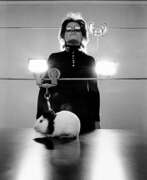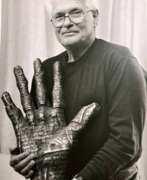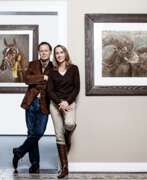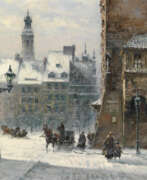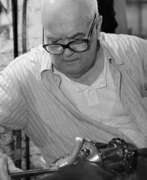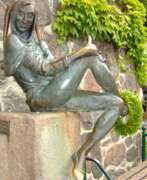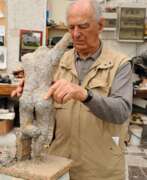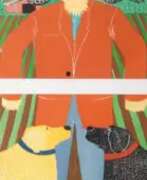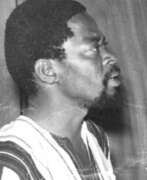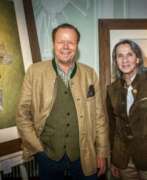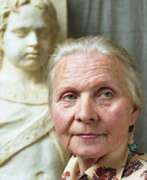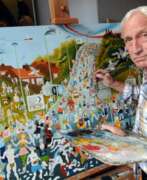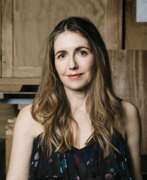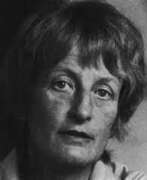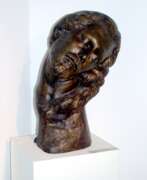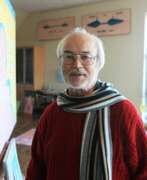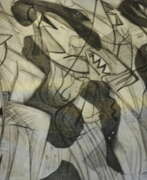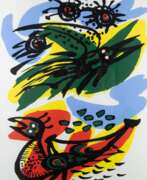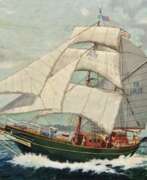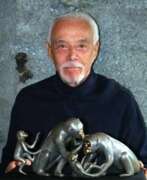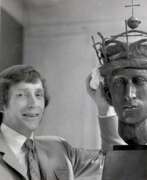Animalists Contemporary art
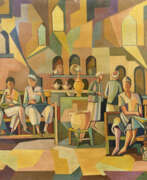

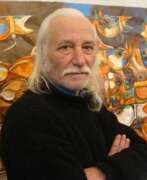

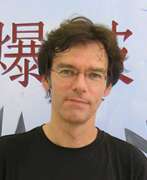

Andreas Amrhein is a contemporary german artist. His first verified exhibition was Arbeiten auf Papier „Blau“ at Galerie Michael Schultz in Berlin in 1994. Andreas Amrhein is most frequently exhibited in Germany, but also had exhibitions in Austria, China and elsewhere.
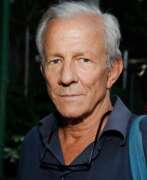

Peter Hill Beard was an American artist, photographer, diarist, and writer who lived and worked in New York City, Montauk and Kenya. His photographs of Africa, African animals and the journals that often integrated his photographs, have been widely shown and published since the 1960s.
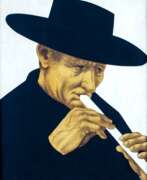

Arne Besser is a contemporary American artist. He received training as an artist at the Art Center School, Los Angeles. There he studied with John Audubon Tyler and Lorser Feidelsson. Beser’s approach to Photo-Realism is to draw from the urban landscape and nature a succinct “set like” image of reality. His city scenes depict New York street life alive with trading and traders, prostitutes and junkies looking for a fix. These visual images iconify the underside of urban life in a way that elevates this point of view to an almost mythic level.
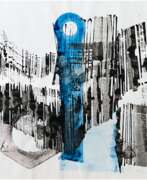

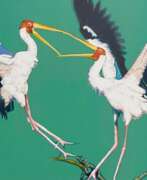

Fran Bull is an American sculptor, painter, and print-maker living and working in Brandon, Vermont and Barcelona, Spain. Bull became known originally for her Photorealism paintings made in the mid 1970s and 80s. In the late 1980s, Bull’s art began to develop towards abstraction, or neo-abstract expressionism. Sparked by her newfound approach to painting, in the mid-1990s Bull began to explore other media. Since that time her artistic output has included performance art, sculpture, mixed media, and printmaking, as well as painting. She has been especially prolific in the area of printmaking. Bull has produced many diverse series of etchings that continue to be exhibited worldwide.
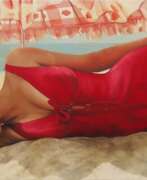

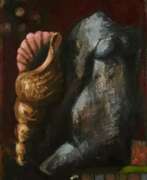

Peter Chevalier is a German painter whose paintings and drawings are close to surrealism. In the 1980s, Chevalier juxtaposed the realistic with the abstract in his paintings. Clearly configured individual but combined things (houses, airplanes, stumps of columns, light bulbs, bones, etc.) dominated, which – as if one were cutting out illustrations from magazines and reassembling them as a collage – are inconsistent in their proportions in the pictorial context.
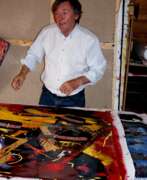

Christian Clerebout is a French contemporary artist. He spent his childhood in Africa, which has left an indelible imprint in his painting style. He studied art from 1966 until 1979 in Paris and Rome. Before settling indefinitely in Brittany, he ran away to North America, lured by the United States, and New York, in particular. This is where his powerful cityscapes evolved: engorged with sweeping movement, brilliant colors and intense darks and lights. He has expanded creatively to include such subject matters as orchestras, airports, elephants and financial themes, but his expressive style is always recognizable.
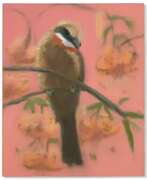

Ann Craven is a contemporary American painter known for her lush depictions of the moon, birds, and multi-colored stripes. Craven’s use of serial motifs belies her interest in ephemeral moments, seasonal cycles, and the changeable qualities of painting. She received her BFA from the Massachusetts College of Art in 1986 and her MFA from Columbia University in 1993. She notably served as an artist assistant to Alex Katz, whose work influenced her own. Much of Craven’s practice revolves around painting en plein air, in this way she has captured the moon on hundreds of nights over the years. The artist currently lives and works in New York. Today, her works are held in the collections of the Whitney Museum of American Art in New York, the Museum of Contemporary Art in Chicago, and the Institute of Contemporary Art in Miami, among others.
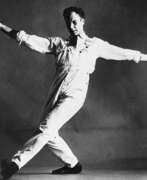

Mercier Philip "Merce" Cunningham was an American dancer and choreographer who was at the forefront of American modern dance for more than 50 years. He frequently collaborated with artists of other disciplines, including musicians, graphic artists and fashion designers. Works that he produced with these artists had a profound impact on avant-garde art beyond the world of dance. There have been numerous exhibitions dedicated to Cunningham's work. Also, his visual art is represented by Margarete Roeder Gallery.
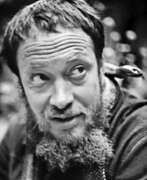

Rostislav Alexandrovich Danov (Russian: Ростислав Александрович Данов) was a Soviet artist of the late twentieth century. He is known as a graphic-animalist, naturalist, writer and professional snake artist.
Rostislav Danov began practicing animalistics in the last years of his life. He was the author of many works, some of which are kept in the Darwin Museum in Moscow. The artist illustrated books, including "Rare and Endangered Animals. Amphibians and Reptiles." Gorlov was also working on an unfinished book, "Year of the Snake," where he planned to describe the seasons of Turkmen nature through the eyes of a gyurza. His manuscripts, hundreds of drawings and 15 volumes of field diaries with graphic sketches have been preserved.


Marcel Dzama is a contemporary artist from Winnipeg, Manitoba, Canada who currently lives and works in New York City. His work has been exhibited internationally, in particular his ink and watercolor drawings. Dzama works extensively in sculpture, painting, collage, and film. The artist is also known for his intricate dioramas and large scale polyptychs that draw from his talents across a range of media. Dzama works in multiple disciplines to bring his cast of human figures, animals, and imaginary hybrids to life, and has developed an international reputation and following for his art that depicts fanciful, anachronistic worlds.
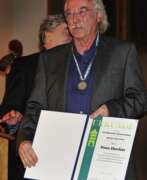

Klaus Eberlein was a German graphic artist, illustrator and ceramic sculptor. He initially completed training as a chromolithographer. From 1962 to 1968 he attended the Academy of Fine Arts in Munich, and from 1968 he was a master student of Hermann Kaspar, receiving a final diploma from the academy. Eberlein was a member of the Association for Original Etching, the Dachau Artists' Association and the Munich Artists' Association. In 2013 he was accepted into the South German literary association Münchner Turmschreiber.
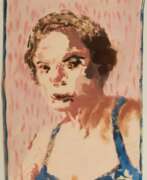

Simon English is a contemporary british artist. He is best known for his large and small-scale 'painted drawings' in which he mingles his distinctive imagery and words. He moves lightly between tight draftsmanship and a playfully sloppy application of colour and line. Language is paramount with diaristic musings interspersed with song lyrics, poetry and humorous one-liners. Self-described as 'automatic', his work has the spontaneity of stream-of-consciousness, exploring themes of love and loss, as well as gay and popular culture. Simon English lives and works in London. He emerged on the London Art scene in 1994 with an exhibition of paintings at the Saatchi Gallery as part of Young British Art III. Simon has exhibited internationally at numerous institutions.


Heinrich Faltermeier was a German sculptor. After an apprenticeship as a goldsmith and years of travel, including to Spain, Faltermeier studied from 1936 to 1943 at the Academy of Fine Arts in Munich. He worked in accordance with the Nazi concept of art and created war memorials. From 1938 to 1944, with the exception of 1941, he was represented at all major German art exhibitions. Faltermeier's preferred working materials as a sculptor were bronze, marble and wood.


Maria Paula Figueiroa Rego was a Portuguese-British visual artist known particularly for her paintings and prints based on storybooks. Rego's style evolved from abstract towards representational, and she favoured pastels over oils for much of her career. Her work often reflects feminism, coloured by folk-themes from her native Portugal.


Fritz Fleer is a German painter and sculptor. He studied at the Hamburg University of Fine Arts in the class of Edwin Paul Scharf.
As independent artist, Fritz Fleer has been creating works for urban planning since the 1950s; in Hamburg he was commissioned for 17 sculptures by the municipal housing company SAGA.


Walton Ford is an American artist. He is known for his large-scale, highly detailed paintings that depict natural history subjects and explore the relationships between humans and animals.
Ford studied at the Rhode Island School of Design and later from Yale University. His work is inspired by the tradition of natural history painting, but he subverts this tradition by using his paintings to critique colonialism, environmental degradation, and the ways in which humans have interacted with the natural world.
Ford's paintings are highly detailed and often include multiple narratives within a single image. He uses a combination of watercolor, gouache, and ink to create his large-scale works, which can be several feet in height and width. His paintings are also highly stylized, featuring elements of graphic design and pop culture.
Ford has exhibited his work extensively, including at the Whitney Museum of American Art in New York, the Hamburger Bahnhof Museum in Berlin, and the Musée de la Chasse et de la Nature in Paris. His work is also held in the collections of several major museums, including the Museum of Modern Art in New York and the Smithsonian American Art Museum in Washington, D.C.
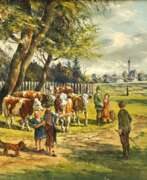

Alfred Fritzsching is a German artist known as Painter, graphic artist, draftsman, sculptor, commercial, commercial graphic artist. He began his training as a commercial graphic artist at the Blocherer School for Graphic and Advertising in Munich and worked as an advertising specialist. In 1970 Alfred Fritzsching became a member of Munich Artists 'cooperative and participated in exhibitions at the Haus der Kunst in Munich. From 1978, he worked as a freelance painter and also as board member and juror of the Munich Artists' Cooperative.


Piero Gilardi is an Italian painter and decorator. A catalytic figure in the Arte Povera movement centred in Turin in the late 1960s, Gilardi's utopian and selfless commitment to the association of neo-avant-garde artists from Western Europe and North America made him one of the most influential artistic figures of the period.
Piero Gilardi became internationally renowned and witnessed the influence of Pop Art in Europe. An itinerant artist, theorist and organiser, he contributed to the birth of Arte Povera, especially working to establish relationships with other similar initiatives that were simultaneously taking place outside of Italy.
Much of Gilardi's later work is united by a theme or interaction between the work and the viewer. The master has devoted more than a decade to his most ambitious project, Parco Arte Vivente (Park of Living Art or PAV). A collaborative effort that grew out of Gilardi's design, the PAV is a monumental undertaking that has transformed an abandoned plot of land in the heart of Turin's working-class Lingotto district into a six-acre green space dedicated to public, environmental and artistic interests.


Alexei Nikolaevich Glukharyov (Russian: Алексей Николаевич Глухарёв) is a Soviet and contemporary Russian artist. He is known as a painter and graphic artist, as well as a teacher.
Alexei Glukharyov worked as an art teacher and graphic designer in Central Asia at the beginning of his career. In 1984 his first solo exhibition in Moscow took place. From 1984 to 1990 he created a large collection of horse portraits for state stud farms and breeding farms. His works have been exhibited in Russia and abroad and are also in private and museum collections.


Vadim Alexeyevich Gorbatov (Russian: Вадим Алексеевич Горбатов) is a Soviet and contemporary Russian artist. He is known as a painter and graphic artist, animalist.
Vadim Gorbatov creates works that are based on field observations and realistic sketches. The artist studied the animal world in his travels from the Siberian tundra to the jungles of Cambodia. He has illustrated many books, including the Red Book of the USSR, and is involved in international projects such as the Artists for Nature Foundation, in which Gorbatov is the only Russian participant. He is also a member of the Union of Artists of Russia and the Wildlife Artists' Union of Great Britain.
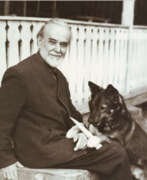

Dmitry Vladimirovich Gorlov (Russian: Дмитрий Владимирович Горлов) was a Soviet artist of the twentieth century. He is known as a graphic artist, sculptor, illustrator, master of decorative and applied plastic art and is considered the founder of Soviet animalistics.
Dmitry Gorlov is the author of monumental and decorative and easel sculptures, as well as toys made of different materials. He created a fountain and bas-reliefs for the Moscow Zoo, as well as reliefs on the monument to the fable writer I. A. Krylov on the themes of his fables. Gorlov also worked at the Gzhel ceramic factory, creating animal statuettes.
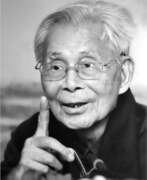

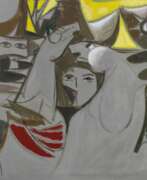

Kadhim Haydar was a highly respected Iraqi artist, poet, author, stage-set designer and educator who, as part of the first generation of modern Iraqi artists, had a major influence on the direction of modern Iraqi art. His artworks are noted for their use of symbolism, myth and poetic allegory within a contemporary framework. His earliest works drew inspiration from the suffering of the Iraqi labourer. He presented workers as heroes with well-developed musculature, chiselled features and an imposing presence as they faced their daily struggless. His later work sought to combine his passion for Iraqi literature, poetic allegory, symbolism and abstraction into works that were primarily narrative and dealt with themes of good versus evil. For instance, he employed ancient aesthetic principles such as repeating geometric patterns derived from ancient Mesopotamian art traditions. He also included poetry in some of his artworks.




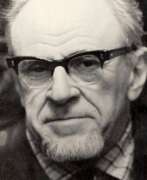

Georgy Nikolaevich Karlov (Russian: Георгий Николаевич Карлов) was a Soviet artist of the second half of the twentieth century. He is known as a painter, graphic artist and illustrator.
Georgy Karlov began his career by teaching drawing in schools, during the Great Patriotic War he drew anti-fascist and propaganda posters. During his career he illustrated more than 100 children's books, collaborated with the magazine Murzilka and illustrated "adult" satirical works. The artist created realistic depictions of animals with anthropomorphic features and rich facial expressions. His book-textbook "The Image of Birds and Animals" collected the experience of an animalist and filled the gap in the literature on the image of animals.


Helen Khal was an American artist and critic of Lebanese descent. She started her painting career at the age of 21. She held her first individual exhibition in 1960 in Galerie Alecco Saab in Beirut. Her other one-woman shows took place at Galerie Trois Feuilles d'Or, Beirut (1965); Galerie Manoug, Beirut (1968); at the First National Bank, Allentown, Pennsylvania (1969); in Kaslik, Lebanon (1970); at the Contact Art Gallery, Beirut (1972, 1974 and 1975) and at the Bolivar Gallery in Kingston, Jamaica in 1975. Her work also appeared in the Biennales of Alexandria and São Paulo. She also taught art at the American University of Beirut from 1967 to 1976 and at the Lebanese American University from 1997 to 1980. She inspired many other artists. Helen Khal was also recognized as an author and critic. "From 1966 to 1974, Helen Khal was Art Critic to two Lebanese periodicals, The Daily Star and Monday Morning.
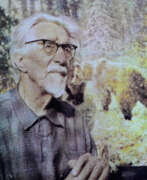

Alexey Nikanorovich Komarov (Russian: Алексей Никанорович Комаров) was a Russian and Soviet artist of the twentieth century. He is known as a painter, sculptor and animalist.
Alexey Komarov became famous for his illustrations in children's books and graphic works. His works cover a variety of subjects, from landscapes to animals. He has also created posters on a variety of subjects, including children's health care and the defense of the homeland during World War II. Komarov is also known for his watercolors as well as his sculptural works, including animal figures and busts. His works decorate various museums and exhibition pavilions.
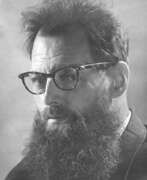

Nikolay Nikolaevich Kondakov (Russian: Николай Николаевич Кондаков) was a Soviet artist of the twentieth century. He is known as a graphic artist and animal painter, as well as a scientist-biologist.
Nikolay Kondakov was involved in biological research, working in various research institutes and taking part in expeditions. His significant contribution to science lies in the creation of drawings of fauna representatives. These illustrations were used in publications such as the Great Soviet Encyclopedia, Red Books, animal atlases, and textbooks. Kondakov created tens of thousands of drawings, making him a significant figure in both biology and the art of artistic illustration.
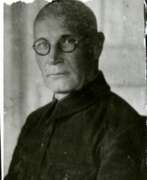

Georgy Dmitrievich Lavrov (Russian: Георгий Дмитриевич Лавров) was a Russian and Soviet sculptor of the twentieth century. He is known as a portraitist, monumentalist, animalist and representative of the Art Deco style.
Georgy Lavrov created propaganda posters at the beginning of his career in collaboration with poet Vladimir Mayakovsky. He then developed his style during a business trip to Paris under the influence of the French animalist sculptor François Pompon. Returning from France in 1935, he created the famous sculptural composition "Thank you Comrade Stalin for our happy childhood!". However, in 1938 the artist was arrested and convicted, served his sentence in the camps, and in 1954 was rehabilitated.
Lavrov left a significant artistic legacy.


David Lawrence Levinthal is an American photographer who lives and works in New York City. He uses small toys and props with dramatic lighting to construct miniature environments for subject matters varying from war scenes to voyeurism to racial and political references to American pop culture. Levinthal has produced a diverse oeuvre, utilizing primarily large-format Polaroid photography.


Li Tianbing is a Chinese artist. Li Tianbing’s body of work is characterized by the dual influence of the Far-East and the West: the first being a legacy of Chinese painting imbued with Taoism, the second coming from the teachings of art professors such as Vladimir Veličković, Christian Boltanski and Giuseppe Penone while he studied at the Fine Arts School in Paris. His work was marked by a pivotal moment in 2006, when he compiled a family album comprising portraits of him as a child, for the purpose of denouncing the one-child policy, thus depicting an imaginary family through replications of himself. He henceforth developed a new visual language in which portraits abound, creating through his art a dialog between reality, imagination and fantasy. When working on his compositions, Li Tianbing essentially uses oil paint; however, another of his main means of expression remains drawing with Indian ink. He also enjoys working with watercolours, alternating between Chinese and European paintbrushes.


Judith Linhares is an American painter, known for her vibrant, expressive figurative and narrative paintings. She synthesizes influences including Expressionism, Bay Area Figuration, Mexican modern art and second-wave feminism, in work that flirts with abstraction and balances visionary personal imagery, expressive intensity, and pictorial rigor. In the early 1970s, Linhares created narrative drawings and assemblages that appropriated commonplace or "craft" materials and feminine imagery (flowers, eggs, swan feathers, domestic scenes). After 1980 she developed a Symbolist allegorical world of enigmatic, bulbous-headed creatures, narcoleptic nudes, phantasms, figures in boats, and human metamorphosis. Her fantastic imagery was balanced by lush color, painterly sensual surfaces, and sure design. Through the 1990s, critics noted in her work a sunnier palette, increasingly abstract and ambiguous imagery, and a growing facility with a naïve drawing style. In the 2000s, Linhares has turned to female nudes (often monumental), visionary landscapes, floral still lifes and animals. Linhares has been recognized with more than forty-five one-person exhibitions and major awards from the American Academy of Arts and Letters and John Simon Guggenheim Memorial Foundation.




Andrew Mansfield is a British Painter, born in Leicester, who studied at Loughborough College of Art and Design, 1970-3, and Portsmouth Polytechnic, 1976-9. In 1987 he was an artist-in-residence in Lisbon. His solo shows included Spacex Gallery, Exeter, 1984; Winchester Gallery in Winchester, 1985; Midland Group, Nottingham, the same year; and Anthony Reynolds, 1986.




Yevgeny Pavlovich Melnikov (Russian: Евгений Павлович Мельников) was a Soviet artist of the second half of the twentieth and early twenty-first centuries. He is known as a painter, teacher and poet who had a great influence on the development of the national school of modern painting in Uzbekistan.
Yevgeny Melnikov excelled in portrait painting, still life, landscape and animalistic compositions. His works were characterized by painterly temperament, energy of stroke and non-standard compositional solutions. In his works one can find both traditional elements of still life (fruits, flowers) and unusual objects (organ pipes, fish). The master also introduced into his compositions fragments from the works of his favorite French post-impressionists.
Melnikov's works are in museums and private collections in Russia, France, Germany, Holland, Sweden and many other countries.
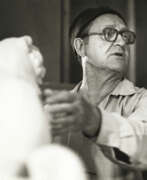

Evgeny Vasilievich Nikolaev (Russian: Евгений Васильевич Николаев) was a Soviet and Russian artist of the second half of the twentieth and early twenty-first centuries. He is known as a sculptor, stonecutter, animalist and teacher.
Evgeny Nikolaev was a regular participant of animalistic exhibitions both in the Soviet Union and abroad, which contributed to his creative development. He was also a pedagogue, teaching drawing and composition at the Moscow Institute of Technology. His multifaceted skill was expressed in working with different materials, from stone and porcelain to metal. Nikolaev's sculptures are in the collections of various museums.
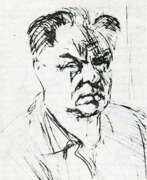

Georgy Evlampievich Nikolsky (Russian: Георгий Евлампиевич Никольский) was a Soviet artist of the mid-twentieth century. He is known as an animal graphic artist and illustrator.
Georgy Nikolsky from a young age was fond of zoology and drawing animals. The first book with his illustrations was published in 1935. In the 1940s and 1960s, Nikolsky became a sought-after animal artist who designed many books, including Bernard Euvelmans' "In the Footsteps of Unknown Animals" and Felix Salten's "Bambi". He also collaborated with Diafilm Studios, creating drawings for the diafilm based on Rudyard Kipling's Mowgli.


Vitaly Nikolayevich Onkov (Russian: Виталий Николаевич Оньков) was a Soviet and Permian Komi artist of the last third of the twentieth and early twenty-first centuries. He is known as a graphic artist and sculptor.
Vitaly Onkov created works reflecting the nature and fauna of the region, as well as elements of Permian Komi pagan and pseudo-Christian mythology. The artist created many paintings and graphic works, including drawings with Permian Komi folk types. He was also one of the authors of the coat of arms and flag of the Permian Komi Autonomous District of the Russian Federation.


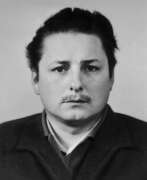

Victor Alexandrovich Otiev (Russian: Виктор Александрович Отиев) was a Soviet and Russian artist of the second half of the twentieth century. He is known as a painter, landscape painter and animalist.
Victor Otiev worked in a variety of genres, including portraits, landscapes and studies from life. One of his favorite subjects was equestrianism. His style evolved from broad, energetic brushstrokes in his works of the 1950s and 1960s to a decorative and graphic style later in his career. In the works of the 1980s Otiev focused on color, decorative planes and rhythmic organization of space.
The master's works are in museums and private collections around the world.
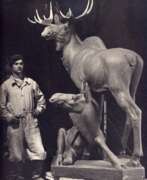

Georgy Nikolaevich Popandopulo (Russian: Георгий Николаевич Попандопуло) was a Soviet artist of the second half of the twentieth century. He is known as an animal sculptor, famous for his monumental and easel works.
Georgy Popandopulo began his independent career in 1959, creating park sculptures and souvenirs for the Art Fund of the RSFSR. His monumental animalistic works are installed in various Russian cities. Popandopulo's works are kept in renowned museums in Russia and abroad, including the State Tretyakov Gallery and the State Russian Museum.
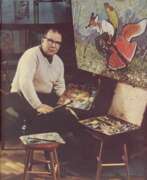

Yevgeny Mikhailovich Rachev (Russian: Евгений Михайлович Рачёв) was a Soviet artist of the twentieth century. He is known as a painter, graphic artist, animalist, and illustrator.
Yevgeny Rachev specialized in illustrations for folk tales and fables from different cultures, as well as for works of classical literature. He favored stories in which the main characters were animals, embodying their natural characters and habits. Thanks to a subtle psychological analysis, the artist gave his illustrations expressiveness and social sounding. His works are valued for their accurate rendering of animal habits and detailed settings.
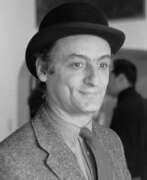

Larry Rivers (born Yitzroch Loiza Grossberg) was an American artist, musician, filmmaker, and occasional actor. Considered by many scholars to be the "Godfather" and "Grandfather" of Pop art, he was one of the first artists to merge non-objective, non-narrative art with narrative and objective abstraction.
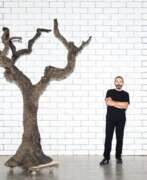

Ugo Rondinone is a Swiss-born artist widely recognized for his mastery of several different media — most prominently sculpture, drawing and painting, but also photography, architecture, video and sound installation — in the largely figurative works he has made for exhibitions in galleries, museums and outdoor public spaces around the world. He has never limited himself to a particular material, no more than he has to a single discipline. Lead, wood, wax, bronze, stained glass, ink, paint, soil and stone are all tools in a creative arsenal that the artist has employed to extend the Romantic tradition in works that are as sensitive to the passage of time as to the nuances of body language and the spoken word.




Sebastião Ribeiro Salgado is a Brazilian social documentary photographer and photojournalist.
He has traveled in over 120 countries for his photographic projects. Most of these have appeared in numerous press publications and books. Touring exhibitions of his work have been presented throughout the world.
Salgado is a UNICEF Goodwill Ambassador. He was awarded the W. Eugene Smith Memorial Fund Grant in 1982, Foreign Honorary Membership of the American Academy of Arts and Sciences in 1992 and the Royal Photographic Society's Centenary Medal and Honorary Fellowship (HonFRPS) in 1993. He has been a member of the Académie des Beaux-Arts at the Institut de France since April 2016.


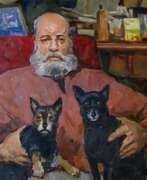

Igor Konstantinovich Skorobogatov (Russian: Игорь Константинович Скоробогатов) was a Soviet and Russian artist of the second half of the twentieth century. He is known as an animal painter.
Igor Skorobogatov graduated from the Repin Leningrad Institute of Painting, Sculpture and Architecture and specialized in animal imagery. His artistic heritage also includes genre and battle compositions, portraits and landscapes. The master's works are in famous museums, including the State Russian Museum, and in private collections around the world, including in Russia, Great Britain, France, Japan and other countries.
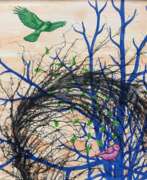

Hermann Standl is a German contemporary painter. Stylistically, his work can be located between the Neue Wilden, Concrete Art and Pop Art. The artistic oeuvre of Hermann Standl is complex and runs between the poles of abstraction and figuration. His examination of the components of the picture composition, colour, form and space, always remained central. At the beginning of his work, shortly after he left the art academy, he created the lattice paintings. On individual wooden slats, Hermann Standl painted figures in a gestural manner, which, based on the Junge Wilden, convey topoi from everyday existence. Preferred topics were the relationship between humans and their environment or social issues that were topical in the 1990s. Not without an artistic wink, he explores the philosophical limits of the concept of home in a globalized world. The large-format paintings that he created around 2009 bear witness to this confrontation with his Bavarian country of origin. Entirely in the style of Pop Art, Hermann Standl combined iconographic elements of Korean culture, such as the hummingbird, with the landscapes we are familiar with in Germany. The complete break with the figurative painting style came a few years later: Herman Standl's paintings now consist exclusively of geometric shapes and colors. By playing these off against each other and setting them apart, he explores the limits of the visual: Dark colors set against light create dynamics, concrete forms form the pictorial space.
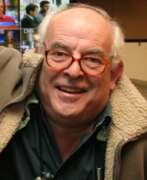

Ralph Idris Steadman is a British illustrator best known for his collaboration and friendship with the American writer Hunter S. Thompson. Steadman is renowned for his political and social caricatures, cartoons and picture books. As well as writing and illustrating his own books and Thompson's, Steadman has worked with writers including Ted Hughes, Adrian Mitchell and Brian Patten, and also illustrated editions of Alice in Wonderland, Treasure Island, Animal Farm, the English translation of Flann O'Brien's Gaelic-language classic The Poor Mouth, and most recently, Fahrenheit 451. Steadman has drawn album covers for numerous music artists, including the Who, Exodus, Frank Zappa and Ambrosia, and the lead banner for the gonzo journalism website GonzoToday.com.


Anett Stuth is a German photographer. With her photographs, Anett Stuth invents multiple architectures in which interior and exterior, high and popular culture, photography and painting overlap. From basic documentary motifs, Stuth layers and collages imaginary interiors, urban or natural landscapes. At the same time, they make the possibility space of the virtual age perceptible. With the technique she has been developing since 2003, Stuth transcends the usual dimension of photographic space and redefines it.


Kaya Theiss is a contemporary american artist. Her first verified exhibition was Möpse at Galerie Thomas Hühsam in Offenbach in 1998, and the most recent exhibition was Walhalla at Galerie Thomas Hühsam in Offenbach in 2016. Kaya Theiss is most frequently exhibited in Germany, but also had exhibitions in Spain, United States and elsewhere.


Rob Thom is a contemporary american artist. He received his MFA from the University of California, Los Angeles in 2004. His work has been featured in international exhibitions. His work is held in numerous private and public collections. Rob Thom’s densely allegorical paintings are keen, satirical observations of contemporary life. The artist brings a particular carnival of American grotesque onto the canvas with wry humor, painstaking observation and deft skill. Touching upon the traditions of painting and art history, including James Ensor’s crowds and Pieter Brueghel’s busy tableaux of peasants, Rob Thom’s compositions vividly capture everyday life and all the banal and absurd vagaries of the human condition.
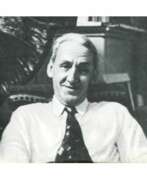

Vadim Vadimovich Trofimov (russisch: Вадим Вадимович Трофимов) was a Soviet artist of the mid-twentieth century. He is known as an animal painter, sculptor and graphic artist.
Vadim Trofimov worked in zoos as an artist, cooperated with the publishing houses "Children's Literature" and "Prosveshchenie", illustrated the magazine "Murzilka". In the 1960s, he focused on the so-called sculpture "on metal patterns". The master founded the section of animalistics at the Moscow Union of Artists, popularizing this genre. His contribution to animalistic art has left a significant legacy in Russia.
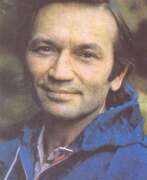

Ruben Artyomovich Varshamov (Russian: Рубен Артёмович Варшамов) was a Soviet and Russian artist of the second half of the twentieth century. He is known as a graphic-animalist and illustrator of children's books.
Ruben Varshamov created illustrations for more than 50 books of the publishing houses "Children's Literature", "Malysh", "Raduga", "Rosman" and others. He also created surrealistic cycles in paintings, etchings and lithographs based on classic works by various authors. In 1977, the artist became editor-in-chief of the humorous children's magazine Vesyolye Kartinki, which he headed until his death.


Ingeborg von Einsiedel, a German graphic artist, studied at the State Academy for Graphic Arts and Book Trade in Leipzig. She worked closely with Karl Max Schneider, the director of the Leipzig Zoo, and was responsible for the signage of the enclosures and the animal books. After Schneider's death, she took care of his scientific legacy and became the "soul" of the zoo. She also created wood engravings depicting animals and plants.


T. J. Wilcox is a contemporary American artist. Wilcox’s work is characterized by a fascination with personal narrative and the ways in which history is always under construction, woven from fact, myth, memory, associations, and the bombardment of information we all receive on a moment-to-moment basis. T. J. Wilcox is mainly known for his super 8 films transferred to video, 16 mm film projections, collages and installations of famous people and their glamorous – sometimes harrowing and dramatic – stories. Fact meets fiction (at times the artist’s own fantasy or history) in beautifully haunting portraits of the famous Marie Antoinette, Marlene Dietrich, Czar Nicholas of Russia, or the Marchesa Luisa Casati. These portraits continue in his work with the not so famous, such as his close friends, the superintendent of his studio building and his beloved French Bulldog. The collaged films are often romantic and decadent in their subjects and subject matter, and their stunningly beautiful vignettes often blur biography and autobiography and embrace the romantic history and escapism of cinema.
